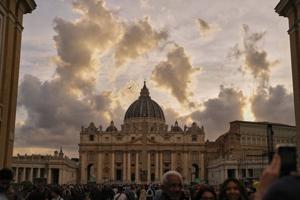Born Jorge Mario Bergoglio from Argentina, Francis made history in 2013 when he became the Catholic Church’s first Latin American pontiff. Known for his progressive stances on social issues, he died in his residence in the Vatican on Monday, hours after delivering his yearly address on Easter Sunday. During his 12-year papacy, Pope Francis became known for his advocacy of immigrants and the poor, as well as his environmental activism.
He took his papal title after Saint Francis of Assisi of Italy (1181-1226)—widely recognised for his profound love of animals and nature, and his commitment to living a life of poverty and service. St Francis of Assisi believed all of God’s creations, including animals and nature, should be treated with respect and reverence. He renounced a life of wealth to embrace a simple, poor lifestyle, dedicating himself to serving the poor and needy.

His commitment to poverty became the defining characteristic of the Franciscan order that he founded, that continues to be one of the largest in the Roman Catholic Church today. The order emphasises service, poverty and the importance of living in faith. Pope Francis’ tenure was characterised by humility and outspoken support of the world’s poor and marginalised.
The media picked up on his humility as soon as he was appointed Pope, when he returned to the boarding house where he was staying to pay his bill personally, rather than send an assistant. He even chose to live in a simple two-room apartment rather than the luxurious papal accommodations in the Vatican’s Apolistic Palace. He donated his monthly salary of about $32,000 to charity; and when gifted a custom designed Lamborghini car painted in white and gold to reflect the Vatican flag, costing around 200,000 euros, he duly blessed it before it was auctioned, fetching nearly $1 million which was donated to charity.
Pope Francis actively worked to improve the lives of the homeless in Vatican City and surrounding areas, and converted a luxurious 19th-century palace into a shelter for homeless individuals and it included meals and other essential services. He influenced the construction of public bathrooms in St Peter’s Square to include showers and a barber shop for the homeless, and founded the World Day of the Poor to raise poverty awareness and encourage action to help those in need. The ultra “noble” Pope personally donated one million euros for the construction of 20 small apartments for homeless individuals, hosted lunches and personally dined with them, further demonstrating his personal commitment to caring for the marginalised.
Pope Francis will go down in history for emphasising the importance of treating the homeless with dignity and respect, and referred to them as “nobles of the street”. Pope Francis urged the Church to be more actively involved in addressing homelessness and also asked the Diocese of Rome to offer vacant properties or unused facilities to house the homeless. He emphasised the importance of providing not only shelter but also dignity and fraternal hospitality to those in need, and called for those in more fortunate positions to “break through that inner deafness which prevents us from hearing the stifled cry of pain in the frailest”.
In early December 2013, Pope Francis gave an “Apolistic Exhortation” calling for big changes in the Catholic Church, including rethinking long-held but antiquated customs. His philosophy was “I prefer a Church which is bruised, hurting and dirty because it has been out in the streets rather than a Church which is unhealthy from being confined and from clinging to its own security.” The Pope’s last wish was to be buried without fanfare—a simple grave, directly in the earth, without marble, gold or any grandeur, with the name “Franciscus” carved in Latin.
He also expressed his desire to rest in the Basilica of St Mary Major rather than the traditional burial site of St Peter’s Basilica in the Vatican. The name Franciscus became widely known after the canonisation of St Francis of Assisi in 1228. This last rite is a testament of the humility and simplicity that defined Pope Francis’ life and papacy.
May the “father of the nobles of the street” rest in peace..
Politics

Pope Francis, patron of the ‘Nobles of the Street’

Born Jorge Mario Bergoglio from Argentina, Francis made history in 2013 when he became the Catholic Church’s first Latin American pontiff. Known for his progressive stances on social issues, he died in his residence in the Vatican on Monday, hours...















